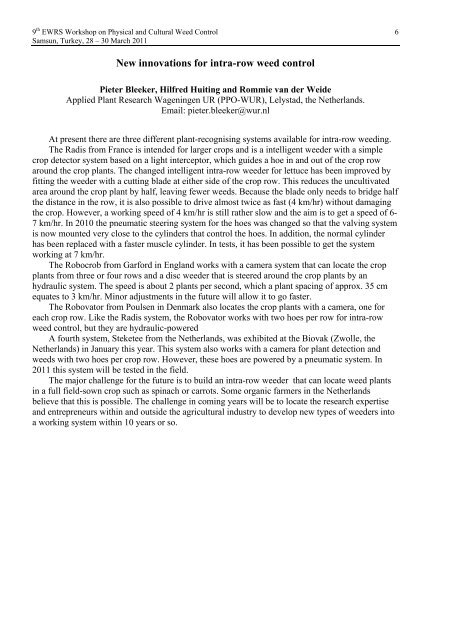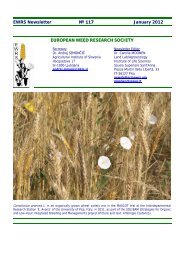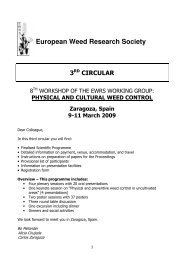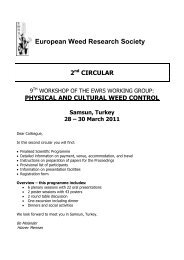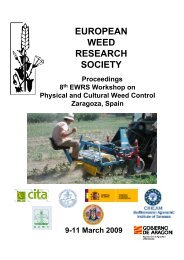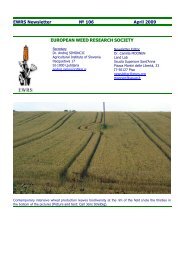Physical and Cultural Weed Control Working Group of - European ...
Physical and Cultural Weed Control Working Group of - European ...
Physical and Cultural Weed Control Working Group of - European ...
You also want an ePaper? Increase the reach of your titles
YUMPU automatically turns print PDFs into web optimized ePapers that Google loves.
9 th EWRS Workshop on <strong>Physical</strong> <strong>and</strong> <strong>Cultural</strong> <strong>Weed</strong> <strong>Control</strong> 6<br />
Samsun, Turkey, 28 – 30 March 2011<br />
New innovations for intra-row weed control<br />
Pieter Bleeker, Hilfred Huiting <strong>and</strong> Rommie van der Weide<br />
Applied Plant Research Wageningen UR (PPO-WUR), Lelystad, the Netherl<strong>and</strong>s.<br />
Email: pieter.bleeker@wur.nl<br />
At present there are three different plant-recognising systems available for intra-row weeding.<br />
The Radis from France is intended for larger crops <strong>and</strong> is a intelligent weeder with a simple<br />
crop detector system based on a light interceptor, which guides a hoe in <strong>and</strong> out <strong>of</strong> the crop row<br />
around the crop plants. The changed intelligent intra-row weeder for lettuce has been improved by<br />
fitting the weeder with a cutting blade at either side <strong>of</strong> the crop row. This reduces the uncultivated<br />
area around the crop plant by half, leaving fewer weeds. Because the blade only needs to bridge half<br />
the distance in the row, it is also possible to drive almost twice as fast (4 km/hr) without damaging<br />
the crop. However, a working speed <strong>of</strong> 4 km/hr is still rather slow <strong>and</strong> the aim is to get a speed <strong>of</strong> 6-<br />
7 km/hr. In 2010 the pneumatic steering system for the hoes was changed so that the valving system<br />
is now mounted very close to the cylinders that control the hoes. In addition, the normal cylinder<br />
has been replaced with a faster muscle cylinder. In tests, it has been possible to get the system<br />
working at 7 km/hr.<br />
The Robocrob from Garford in Engl<strong>and</strong> works with a camera system that can locate the crop<br />
plants from three or four rows <strong>and</strong> a disc weeder that is steered around the crop plants by an<br />
hydraulic system. The speed is about 2 plants per second, which a plant spacing <strong>of</strong> approx. 35 cm<br />
equates to 3 km/hr. Minor adjustments in the future will allow it to go faster.<br />
The Robovator from Poulsen in Denmark also locates the crop plants with a camera, one for<br />
each crop row. Like the Radis system, the Robovator works with two hoes per row for intra-row<br />
weed control, but they are hydraulic-powered<br />
A fourth system, Steketee from the Netherl<strong>and</strong>s, was exhibited at the Biovak (Zwolle, the<br />
Netherl<strong>and</strong>s) in January this year. This system also works with a camera for plant detection <strong>and</strong><br />
weeds with two hoes per crop row. However, these hoes are powered by a pneumatic system. In<br />
2011 this system will be tested in the field.<br />
The major challenge for the future is to build an intra-row weeder that can locate weed plants<br />
in a full field-sown crop such as spinach or carrots. Some organic farmers in the Netherl<strong>and</strong>s<br />
believe that this is possible. The challenge in coming years will be to locate the research expertise<br />
<strong>and</strong> entrepreneurs within <strong>and</strong> outside the agricultural industry to develop new types <strong>of</strong> weeders into<br />
a working system within 10 years or so.


